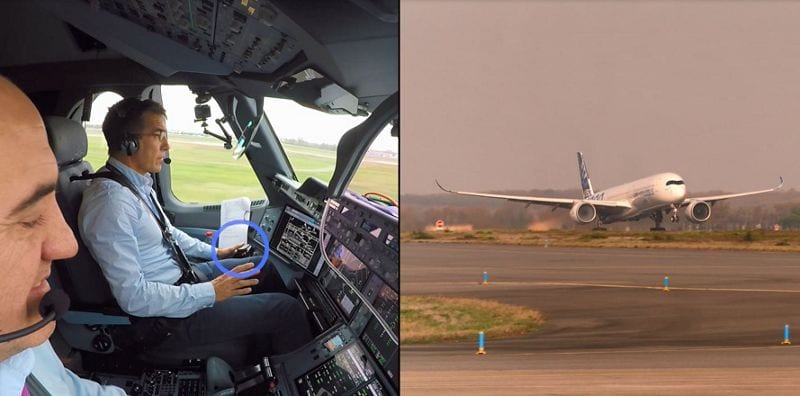
Airbus completed a test flight with its AI-enabled fully automatic vision-based take-off and landing technology. (Airbus)
Ready or not the use of artificial intelligence (AI) and machine learning (ML) in aviation is here. Industry professionals say the use of AI/ML can increase speed, efficiency, workload, and safety to enable more complex technology like autonomous vision-based navigation and data ecosystems.
During a Dec. 9 Global Symposium on the Implementation of Innovation in Aviation panel hosted by the International Civil Aviation Organization (ICAO), industry experts from Thales, Airbus, and EHang talked about new AI/ML technology companies are developing.
“Artificial intelligence is coming with a fast pace and being adopted widely, including in the aviation domain,” Jean-Marc Cluzeau, principal advisor to the European Union Aviation Safety Agency (EASA) executive director, said during the webinar. “While the concept of AI has been in existence since the 1950s, its development has significantly accelerated in the last decade due to three concurrent factors: the capacity to collect and store massive amounts of data, the increase in computing power, and the development of increasingly powerful algorithms and architectures.”
Airbus is using AI for observation tasks like computer vision, time series analysis, and natural language processing, predictions such as hybrid modeling, and decision making, Romaric Redon, head advisor on AI at Airbus, said during the panel.
Skywise, the Airbus data analytics platform, uses AI and ML to gather data about aircraft operations. Skywise has helped Airbus respond to the COVID-19 pandemic by allowing them to analyze flight restrictions and air traffic fluctuations.
“One example of what we do with artificial intelligence on advanced data analytics is really the way we look at our COVID response,” Redon said. “So we’ve built different types of analytics to really analyze the way traffic is evolving, the way airlines would swap their aircraft to go for bigger or smaller aircraft, also to look at the correlations we have between traffic on restrictions, which are applied worldwide. Ultimately we wish we could predict the way the traffic would be stopped. For the services reeling from COVID-19, this is really important for the decision making at the time being.”
AI could have large impacts on the piloting of aircraft. Airbus and EHang, a Chinese company making passenger autonomous aerial vehicles (AV) for urban air mobility (UAM), are both developing AI technology for intelligent navigation. Airbus completed its first taxi, take-off, and landing using vision-based AI this year and EHang uses AI in its autonomous aircraft.

Guangzhou-based EHang is using AI for intelligent navigation. (EHang)
Edward Xu, chief strategy officer at EHang, said EHang’s autopilot system empowered by AI. The system is able to complete everything from take-off to landing enabling a complete flight without a pilot.
“The flight of EHang AV requires no pilot at all and the passengers don’t need to have any piloting skills, they will only need to select the destination airport on the onboard tablet,” Xu said. “…With the intelligent navigation system and accurate GNSS positioning, the airports and the flight paths will be joined by EHang and the local aviation authorities to ensure the reliability of communication and the flight paths to avoid any conflict on the way.”
Predictive maintenance and air traffic control (ATC) will also be revolutionized by AI/ML. Thales and Airbus both use AI for these applications. Optimizing these systems will make airline operations more efficient and environmentally friendly, Beatrice Pesquet-Popescu, director of research and innovation at Thales ATM, said during the panel.
“We use AI processes to build more quickly, more interoperable systems,” Pesquet-Popescu said. “With automatic speech recognition, we help controllers to do their job easier. Machine learning, also helps in monitoring system performance and detecting anomalies, doing predictive maintenance, and increasing the system resilience. And last but not least, the new machine learning algorithms allow the creation of smart twins for our ATC centers for performing continuous improvements through simulations, and also help buyers to make their operations greener by optimizing for tactical and strategical impact.”
While there were many innovative use cases discussed, the overarching conclusion was that the implementation must be driven by safety.
The aviation industry could see the first approvals for AI/ML featured within an air transport category aircraft by 2025 with the prospect of ramping up the use of this technology for commercial and transport aircraft in 2035, Cluzeau said. While these technologies are being developed, EASA published an AI Roadmap based on AI trustworthiness to tackle the ethical and societal issues around AI.
“A European ethical approach to AI is central to strengthen citizens’ trust in the technology,” Cluzeau said. “Only if AI is developed and used in a way that respects widely shared ethical values, can it be considered trustworthy. Therefore, there is a need for ethical guidelines to be built on the existing regulatory framework.”
The EASA AI Roadmap will include ethical guidelines like accountability, technical robustness and safety, oversight, privacy and data governance, non-discrimination and fairness, transparency, and societal and environmental well being, Cluzeau said. To create trustworthiness in AI, EASA will focus on three building blocks: learning assurance, AI explainability, and AI safety risk mitigation.
“We must keep pace with the most recent developments in the field of artificial intelligence,” Cluzeau said. “As you can see, we have a plan and as you can see it relies upon a few key principles: to take on board the ethical dimension of AI, to develop new certification concepts, to work in partnership with industry, and to focus on the EASA staff competency.”